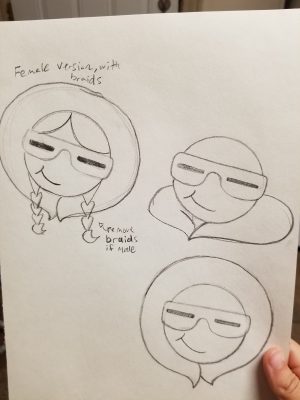How an Inuk artist drew on Arctic Indigenous culture to design a Twitter emoji
Aija Komangapik created a Twitter symbol of an Inuk in snow goggles for Indigenous History Month.

For the third year in a row, an Indigenous artist illustrated the Twitter emoji for Indigenous History Month in Canada. This year, that artist was Iqaluit-born Aija Komangapik.
The emoji showed up throughout the month of June on hashtags like #IndigenousHistoryMonth, #IndigenousPeoplesDay and #IPD.
https://twitter.com/TwitterCanada/status/1267456420124995586
Deciding on one image to represent Inuit and other Indigenous peoples was “tricky,” Komangapik told ArcticToday, because she didn’t want to boil an entire culture down to a single well-worn archetype.
“I wanted to do something that was involved in Inuit culture, but I didn’t want it to be something that’s like, you know, igloo, ulu,” she said.
She took a step back and thought about emoji more generally. “My favorite emoji is just the sunglasses emoji, because it just looks very cheeky and silly and fun,” she said.
With that in mind, she added a Northern twist, replacing the sunglasses with snow goggles and adding a parka hood.
She considered different versions of the image — a bald Inuk, an Inuk with braids. “But eventually, I just thought that I’d like it to be gender neutral so that everyone feels included,” she said. She consulted her family, and her grandmother encouraged her to follow her vision.
Komangapik moved to Quebec as a teenager, and she just completed her first year of studies at Bishop’s University, switching from biochemistry to arts administration midway through the year.
When the coronavirus pandemic moved classes online, Komangapik found herself with a little extra time to work on her art. And then someone from Twitter got in touch.
The Twitter representative had seen Komangapik’s artwork on Instagram, and she asked if Komangapik would like to design this year’s symbol.
The snow-goggled image was the first and only design she submitted. But Komangapik spent a great deal of time considering how to create a symbol that referenced her own culture and experiences while also speaking to other Indigenous peoples.
“It’s very hard to create something that is both inclusive [and also] represents your own culture and doesn’t impede on other people’s cultures,” Komangapik said.
“I wanted to be able to do that with my emoji, which is why it’s not a specific color. It’s not a specific gender. You can project onto it. But you very much understand that it is Inuk.”
Komangapik also illustrated Country Food, a children’s book, and she designed the logo of the Cultural and Indigenous Research in Counselling Psychology program at McGill University.
In 2018, Chief Lady Bird of the Chippewa/Potawatomi designed a Turtle Island emoji. She suggested to Twitter that the artist change every year, in order to capture some of the range of Indigenous culture in Canada.
🌷Thread🌷
Aaniin everyone! Happy Friday! I am so so so honoured that I was asked to create an emoji for #IndigenousHistoryMonth pic.twitter.com/8jeLZYK7PO
— Chief Lady Bird 🦅 ᐅᑮᒪᑫᐧᐱᓀᐢ (@chiefladybird) June 1, 2018
In 2019, Janelle Wawia of the Opwaaganasiniing (Red Rock Indian Band) designed the image of a moose hide on a stretcher.
https://twitter.com/embracecreative/status/1134424043405434880
Komangapik appreciates how Twitter approaches different artists each year.
“It’s very inclusive of all the different cultures,” she said, “by having different artists every single year, but they’re not making it homogenous by trying to force it to be at the same time or presenting everyone and then no one.”


